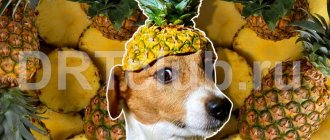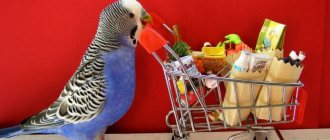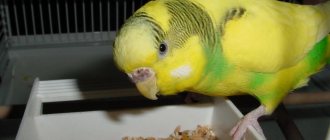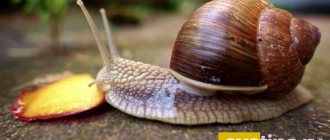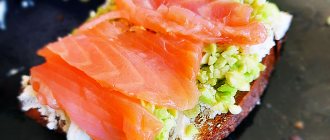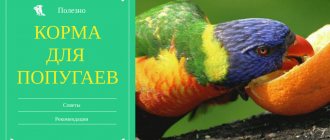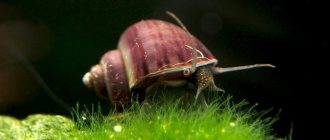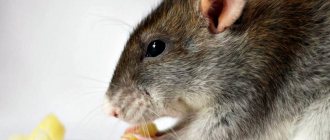Home » Useful Information
The African snail Achatina is an exotic pet. With proper care, the mollusk grows to enormous sizes. It is important for breeders to know what to feed Achatina at home in order to provide them with all the nutrients necessary for life and growth.
- 1.1 What can you feed Achatina
1.1.1 Video: greens in the diet of Achatina
- 1.1.2 Video: feeding Achatina, nutritional supplements
- 2 Achatina diet at home
- 3 Vitamins and minerals
- 4 Sources of calcium in the snail's diet
- 5 How often should you water shellfish?
- 6 What to feed newborns and small snails
6.1 Video: reproduction, laying, how to care for cubs
Basic diet in winter and summer
Achatina are practically omnivorous. In the wild, snails independently regulate their diet, selecting the foods the body needs. The basis for good shellfish health is a sufficient amount of fiber, calcium and protein. The nutrition of domestic Achatina falls entirely on the shoulders of the owner.
The ratio of plant foods and protein-calcium supplements in a balanced snail diet is 70% to 30%.
What can you feed Achatina
The favorite delicacy of mollusks, which supplies them with fiber and vitamins, is juicy plant food. You can include in your daily diet in unlimited quantities:
- Fresh vegetables: cucumbers, carrots, zucchini, pumpkin, Chinese cabbage, broccoli, bell peppers, tomatoes. Beets can be given raw or boiled. White cabbage is doused with boiling water to remove the bitter taste.
- Ripe fruits: apples, melon, pears, peaches, plums. Bananas should be given no more than once a week.
- Greens: lettuce, dill, parsley, spinach, celery, dandelion and plantain leaves, nettles previously scalded with boiling water, beet and carrot tops.
Greens are simply necessary in the diet of Achatina snails
Video: greens in the diet of Achatina
You can pamper your pets with ripe berries: strawberries, cherries, grapes, raspberries. Some of them will like sugar watermelon or exotic coconut.
Achatina will not refuse ripe berries
It is preferable to feed Achatina with hard food; they crunch hard pieces with pleasure and do not disdain even stubs.
Shellfish also obtain fiber from grain mixtures and cereals. Oatmeal, buckwheat, millet, corn, barley, pearl barley, and sunflower grain are useful for Achatina. The ground mixture can be given dry, or it can be steamed with a small amount of boiling water and served cooled. Grains should not be a frequent guest on the snails’ table: they are quite difficult to digest. Use in the diet of sick, weakened snails and babies is contraindicated.
An important component of a snail's diet is protein. Its deficiency leads to slower growth, decreased activity, and dangerous diseases. Achatina alone replenish their protein reserves by happily absorbing boiled poultry and fish. For others who have chosen a vegetarian lifestyle, special protein supplements are required:
- Gammarus is a small freshwater crustacean, sold in pet stores live, frozen and dried. For one snail, 6–7 crustaceans 2 times a week are enough.
Gammarus can be bought at any pet store
- Daphnia - most often found in the form of dry powder, contains a large amount of nutrients, vitamins and microelements, used 2-3 times a week, 1 teaspoon.
Daphnia - protein food for fish and snails
Protein supplements are placed on top of Achatina’s favorite treats. A lettuce leaf or a cucumber circle is perfect as a plate. Vegetable protein is found in mushrooms and legumes.
It is important to remember: moderation is good in everything. An excess of protein is just as dangerous for a mollusk, as is its lack, causing swelling, copious mucus secretion and ultimately the death of the pet.
Video: feeding Achatina, nutritional supplements
Substances and foods that should not be given
The correct diet followed by African mollusks completely excludes a number of foods:
- The main health hazard for Achatina snails is salty food. Salt corrodes the body of the mollusk, causing it incredible suffering.
- All pickled, spicy and fried foods are strictly prohibited.
- You should not include foods high in acid in your pet’s diet: citrus fruits (oranges, tangerines, lemons), sorrel and rhubarb. The acid helps to destroy the Achatina shell.
- Raw potatoes contain a large amount of a substance poisonous to snails - solanine. Potatoes can be offered in small quantities and strictly boiled.
- You should not give shellfish bitter vegetables: onions, garlic, eggplant, radishes, ginger, hot peppers.
- Absolutely any sweets are prohibited in Achatina’s diet.
- Bread, flour products and pasta are too heavy food for delicate shellfish; caring owners avoid eating them.
Needless to say, Achatina should eat only high-quality, unspoiled foods without harmful additives and dyes. Food affected by mold, vegetables with pesticides or traces of household chemicals are dangerous to the health and life of snails.
Vegetables that can be given with restrictions
I personally don’t give the vegetables that will be discussed in this section to the snail, because I don’t see any point in it. Vegetables, fruits, herbs and berries allowed without restrictions are quite enough to diversify your diet. And according to statistics, such products are not particularly welcomed by the snails themselves.
However, if you have a desire, you can also include them in your diet little by little:
- Green peas in pods - give a little, because legumes cause gas.
- Celery is, in principle, not prohibited, but it is very aromatic, so there are concerns about possible reactions to this vegetable (I very rarely offer it to the snail, but it eats it without much enthusiasm).
- Beets – you can give a little, preferably grated. Since raw beets have a laxative effect and are not particularly delicate in taste, I also don’t see much point in feeding snails with them.
- White, red and Chinese cabbage. They are permitted products, but I recommend giving the snail only young leaves. Winter dense cabbage has an islandy flavor, so it is better to replace it with iceberg lettuce, which is more delicate.
- Kohlrabi is also often “vigorous”.
- Artichoke.
- Edible mushrooms – my snail doesn’t like mushrooms. If you give it, it’s very little. Not all mushrooms are well digestible.
Achatina diet at home
Achatina does not require frequent feeding. It is enough to give small snails food once a day. Adults eat even less often: 3–4 times a week (every other day). You should only put food in the terrarium when your pets are awake. It is advisable to do this in the evening. Achatina prefer to lead a nocturnal lifestyle; during the day they usually sleep sweetly, buried in the ground.
Products should be at comfortable room temperature. Treats that are too cold or too hot will cause irreparable harm to the snail. The remaining uneaten food remains from the terrarium in the morning must be removed. You should not offer snails weathered, stale foods.
Is it good for dogs?
Dogs can eat greens to normalize digestion and replenish essential microelements.
Dogs can eat sorrel. Especially if the sorrel is grown in your own garden and thoroughly washed. Although its energy value is negligible, sorrel will help pets get rid of waste and toxins.
You should not give your dog too much sorrel, as oxalic acid can negatively affect kidney function. Dogs should also not be allowed to eat dirty grass.
Sources of calcium in the snail's diet
Calcium is the main element for the construction of a strong and beautiful Achatina shell. An accessible source of useful minerals are calcium supplements:
- Chalk is used in the form of a special feed powder made from a natural mineral, and not those multi-colored crayons that children use to draw on the asphalt. Any hint of chemistry in the treat will make the snail completely indifferent to it.
Feeding chalk can be given to snails for the formation and growth of a strong shell
- The shells of raw eggs are ground into powder. This is easy to do with a regular rolling pin. The shells should first be rinsed thoroughly with warm water and dried thoroughly. It has been proven that the shells of boiled eggs are much less digestible by snails.
- Sepia is the cuttlefish shell loved by snails. Natural is distinguished by its pure white color; any other shades indicate the presence of harmful dyes in the composition of the fertilizer. Before use, it is soaked for several hours to remove the salt in it.
- Shell rock - buy ready-made powder, or grind the shells in a coffee grinder.
Supplements can be given to snails individually, or they can also be mixed and used all at once as part of healthy calcium mixtures.
Can I give it to goats?
Horse sorrel, one of the most common weeds, is harmful to domestic goats.
Sorrel is not a suitable food for goats as it negatively affects intestinal motility. Sorrel can cause constipation and even stop the stomach.
Sorrel is especially dangerous if there is a lot of it in the hay, as this dangerous grass can cause clogging of the stomach and intestines.
How often should you water clams?
Water is the source of life for African snails. It helps maintain body temperature, digest vitamins and minerals, remove toxins from the body, and produce protective mucus.
It is important to give the Achatina snails the opportunity to quench their thirst every time after feeding. For these purposes, you can purchase a spray bottle: mollusks love to drink, licking drops of water from the walls of the terrarium. To avoid dehydration of Achatina, you should regularly moisten the soil in the terrarium and keep a saucer of clean water at room temperature.
Shellfish need water to live.
It is important to choose a container with low sides. Otherwise, the clam may choke. Do not use regular tap water. Its high chlorine content is dangerous for snails. Boiled, filtered, bottled water is suitable for Achatina.
Allowed wild herbs
Let me give you an example of the most common herbs that are easy to collect in the forest:
- Dandelion leaves
- Clover leaves
- Burdock
- nettle leaves
- Plantain leaves
Clover
Dandelion leaves
These herbs are safe. You need to collect them in the forest. And in no case near highways. I don’t recommend it in the yard either - it’s also dirty, the air is polluted with car exhaust, and people often walk their dogs on the grass - you never know what will get there along with the grass.
Naturally, nettles should not be given with stems or freshly picked. Let it sit and wash it well. Actually, the same procedure should be done with all other herbs.
Burdock - in my photo it is quite large, it is better to take young burdock leaves
Plantain
My Chamomile’s personal TOP of wild herbs is:
- Clover
- Plantain
- Dandelion
- Nettle
- Burdock
She eats burdock very sparingly, when she is hunting, she eats nettles lightly, and dandelion sparingly. The plantain is more cheerful and has only young leaves. Clover is my favorite (and hardest to collect). I deliberately do not collect any additional herbs, since these five are enough to diversify the summer diet.
I recommend collecting only young herbs. Huge stringy plantain leaves are unlikely to please snails.
What to feed newborns and small snails
For the first few days after hatching, Achatina snails feed on the shells of their eggs and do not require additional attention. Grown-up babies eat the same things as adults. But to make it easier for them to eat, food is grated or chopped with a knife. It is impossible to feed small Achatina with pureed food: they can suffocate in the loose mass.
Grown-up snails are fed the same foods as adults.
It is important to gradually introduce a variety of delicacies into the diet of small snails in order to form correct eating habits and avoid pathological addiction to a particular product. It's best to start with greens, carrots and apples. The kids' favorite treat is cucumber.
It is necessary to add calcium supplements to food: the need of small Achatina for calcium during the period of intensive growth and shell formation is colossal.
Video: reproduction, laying, how to care for cubs
Bottom line
In this article we tried to tell you what you can feed snails. The list of products to feed snails at home is very extensive, mainly consisting of products of plant origin, calcium and protein supplements. If you have doubts about any product, it is better not to give it. If you have forgotten what is included in the list of permitted products, then remember what a snail eats in nature. What do you feed your pets? Share your experience and write comments in the comments to the article. Health to you and your pets!
4.5 / 5 ( 70 votes)
